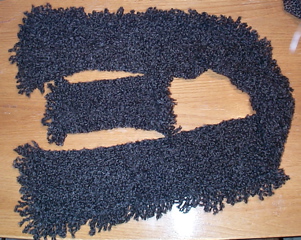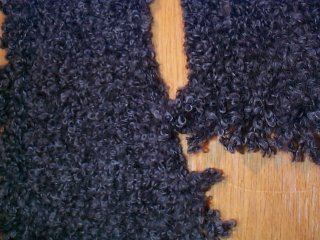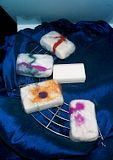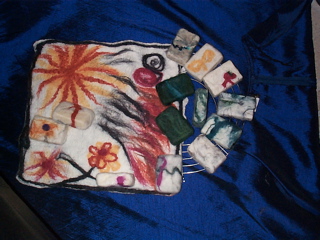Spinning wheels have technical aspects and recently I received this explanation that I though would be good to post:
Spinning wheels are pulley systems. Changing ratios is basically the
same principle as changing gears on a bicycle, except instead of
sprockets and chains, you've got pulleys and drive bands.
Simply put, a ratio of 5:1 means that the drive wheel's circumference is
5 times that of the circumference of the thing being driven (like the
whorl). For every time that the drive wheel completes one rotation, the
thing being driven (whether it's flyer whorl, or bobbin) will rotate 5
times. So if you treadled such that the drive wheel completed 30
rotations (or revolutions) per minute, the flyer or bobbin would
complete 5 times that many, or 150. Your 30 rpm at the drive wheel
becomes 150 rpm at the flyer or bobbin.
If you want your flyer or bobbin to be going faster than that, in order
to make more twist go into your yarn faster as you are spinning, without
different ratios, your only option would be to increase the speed of the
drive wheel, say by treadling faster on a treadle-power wheel.
Increasing your speed to where you are going 60 rpm at the drive wheel
would then increase flyer or bobbin speed in a directly linear way,
still at a ratio of 5:1 -- so now you're going 300 rpm at the flyer.
But, let's say that you have another ratio available to you, of 7 to 1.
In this case, the drive wheel's circumference is 7 times that of the
driven object. Simply changing from the 5:1 ratio to the 7:1 ratio,
without changing the speed at which you're treadling or turning the
drive wheel, changes you from going 30 rpm at the drive wheel and 150
rpm at the driven end, to 30 rpm at the drive wheel and 210 rpm at the
driven end.
So, an application of this principle: let's say that I want to spin a
really fine and high-twist yarn at a rate of, say, 1500 rpm at the
flyer. To do this with a drive ratio of 5:1 on a treadle powered wheel
where each treadle stroke represents a full rotation of the drive wheel,
I'd have to treadle 300 times a minute!! Yowza! There's no way that's
humanly possible. But at a ratio of 30:1, I'd only have to treadle 50
times a minute, to get 1500 rpm at the driven end. ;-)
To sum up, different ratios allow you to get twist into your yarn at
different rates while you are spinning, without changing the speed at
which you treadle (or turn the drive wheel).
Going from a larger drive wheel circumference to a smaller driven item
circumference, you get the biggest speed gains, and fastest flyer/bobbin
rotation relative to treadling speed. Going from smallest drive wheel
circumferene to largest driven item circumference, you get the slowest
flyer/bobbin speed relative to treadling speed. On most modern spinning
wheels, this means if you have your drive band going around the largest
groove on the drive wheel, and the smallest groove on your whorl, you're
going as fast as that wheel can go; if you're going around the smallest
groove on the drive wheel, and the largest groove on the whorl, you're
going as slow as that wheel can go.
Similarly with bicycle gears, some ratios also can require more effort
and force than others, just to get around -- think of shifting to a low
gear, for low-effort pedaling to get uphill, and then a higher gear, for
greater speed on a flat stretch once you get going. The same effect is
in play in pulley systems, but as implemented in spinning wheels, you
typically need to be pushing the limits of your system in order to
detect these effects to any great degree.
Above is by
Abby Franquemont
http://abbysyarns.com/wordpress/
Production Fiber Artist Franquemont Fibers, LLC





